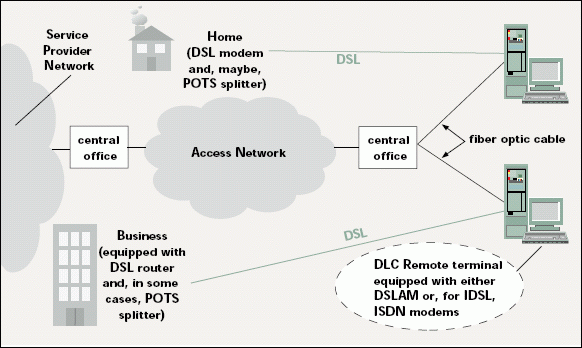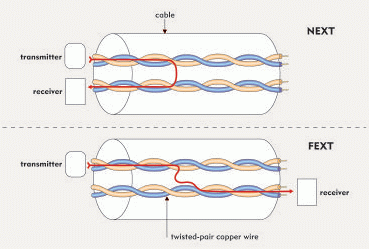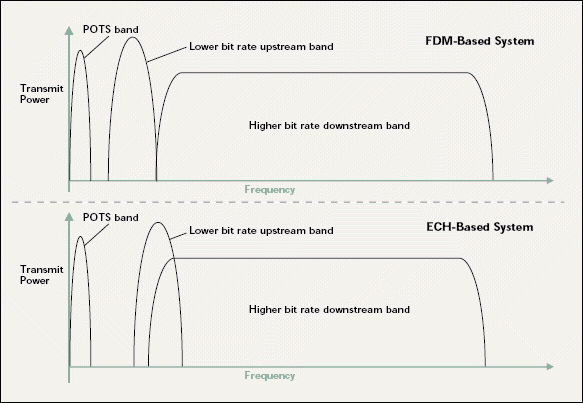POTS and PANS: The Nuts and Bolts of DSL
Articles and Tips: article
01 Aug 2000
Assume for a moment that you're literally standing on a sidewalk by a street. Look overhead. You see those cables running from pole to pole? (If not, they're underground, and you'll just have to imagine them. Work with me here.) Inside those cables are bundles of twisted-pair copper wires used for Plain Old Telephone Services (POTS). Depending on where you live, those same copper wires may also be carrying services far more interesting than POTS.
Those copper wires may also be used for Digital Subscriber Line (DSL) services, which some people are playfully calling Positively Amazing New Services (PANS). If DSL is available in the neighborhood where you're standing, inside those cables, POTS signals are moving, and PANS bits are flying. (For more information about DSL and its availability, see the related article "The DSL Connection: DSL Is Hot--or It's Not.")
DSL is a technology used to transport digital data traffic back and forth across the span of wire between your home or office and the telephone company's central office (CO) or, in a few instances, one of its remote terminals. (For definitions of terms used in this article, see the glossary on the NetWare Connection web site at http://www.nwconnection.com.) DSL requires, among other things, a DSL modem at the customer's premises and a DSL Access Multiplexer (DSLAM) at the CO (or remote terminal).
A DSLAM concentrates data traffic from many DSL subscribers into one high-speed signal suited for the network between the telephone company's CO and an Internet Service Provider's (ISP's) network. In other words, at the CO (or remote terminal), DSL has accomplished its purpose and passes its digital payload along to the asynchronous transfer mode (ATM) or other network connecting the DSL provider's network to an ISP's network. (See Figure 1.)
Figure 1: DLC remote terminals sometimes serve customers that are very far from the CO. These remote terminals are connected to the CO by fiber optic cable (which cannot support DSL) and connected to your home or office by twisted-pair copper wire (which can support DSL). To serve customers in DSL areas, DSL service providers may use IDSL or install specialized ADSL or G.lite DSLAMs in the DLC remote terminals.

The span of wire between your premises and the telephone company's CO is called the local loop. In the context of the Internet, the local loop is frequently referred to as "the last mile," a common bottleneck for Internet traffic. DSL has the potential to eliminate this notorious last-mile bottleneck.
PANS TAKE THE HIGH ROAD, POTS TAKE THE LOW ROAD
The obvious question, of course, is how? How does DSL enable such high transmission rates over the unshielded twisted-pair copper wire used for telephone lines? After all, analog modems use those lines and manage to provide transmission rates of only 56 kbps--and that's only downstream (from the Internet to the user). How then does DSL--using the same copper lines that analog modems use--provide downstream transmission rates of anywhere from 1.5 to 52 Mbps? (For more information about DSL transmission rates, see "DSL Flavors" and "I Feel the Need for Speed" in "The DSL Connection: DSL Is Hot--or It's Not" article.)
DSL enables high-speed transmissions over common telephone lines by exploiting unused frequencies on those lines. POTS guidelines restrict the frequency at which to carry voice between 0 Hz and 3,400 Hz (or 3.4 kHz) of the 1,000,000 Hz (or 1 MHz) available on most copper telephone lines. Analog modems dutifully follow POTS guidelines and operate at these same low frequencies. Consequently, analog modems provide limited transmission rates, historically ranging from 9.6 kbps to 33.6 kbps but more recently reaching 56 kbps (at least downstream).
DSL basically ignores the POTS frequency guidelines and transmits digital signals using the remaining unused frequencies, beginning at about 26 kHz. Sounds simple enough--but it isn't. Several problems arise when you transmit digital signals at high frequencies over ordinary telephone lines. Two problems in particular are inherent to high-speed digital transmissions over copper wire:
Attenuation
Cross talk
FAST SIGNALS CAN'T GO THE DISTANCE
When digital signals are transmitted at high frequencies, these signals lose power quickly, a phenomenon called attenuation. One way to compensate for attenuation is to install repeater equipment along the copper wire to repeat (or refuel) the signal. That's the up side. The down side is this repeater equipment is expensive.
For example, T1 and E1 (the European equivalent of T1) services, like DSL, use existing copper lines to transmit digital signals at higher frequencies than POTS signals. However, these services can be expensive. In the United States, a T1 line can cost as much as U.S. $2,000 per month. One reason T1/E1 services are so expensive is that they require repeater equipment to be spliced into the lines within 2,000 to 3,000 feet of the end points and every 3,000 to 6,000 feet between repeaters (depending on wire gauge). Installing and maintaining this equipment are costly--and consumers of these services pay the price.
At least one of the goals driving the development of DSL is to keep deployment costs (and, ultimately, consumer costs) to a minimum. Thus, DSL was designed to transmit digital signals at high frequencies over the length of most local loops, which is typically 12,000 to 18,000 feet (or 3.7 to 5.5 km), without requiring repeater equipment.
Another way to minimize attenuation is to use thick wire. The thicker the wire, the less the signal attenuation and, consequently, the further the signal can travel. True enough, but DSL service and equipment providers understandably decided from the outset to use the existing 700 million telephone lines installed worldwide rather than replacing them all with newer, thicker copper wire.
The existing cabling plant is typically based on copper wires that were intended to be thick enough only to support POTS but are fortunately thick enough to support DSL as well. The thickness of a wire (its diameter) is referred to as its gauge. Within North America, most telephone copper wires are 1/24" or 1/25" gauge--measurements that are represented as 24 or 25 American Wire Gauge (AWG). Of course, in the rest of the world, wire gauge is measured in millimeters. The wires are typically .4 mm (which equates to approximately 26 AWG) and .5 mm (which equates to approximately 24 AWG).
GOING FARTHER, FASTER--WITHOUT REFUELING
DSL manages to transmit digital signals over the length and gauge of the typical local loop--without requiring repeaters--by using advanced modulation techniques, also called line-coding techniques. Modulation techniques define methods for encoding (or modulating) digital (or analog) signals onto a waveform (the carrier signal) and then using an inverse process, called decoding (or d emodulating), to recover the original signal. (Modulation and demodulation, as you may know, gave rise to the word modem.)
DSL flavors use various modulation techniques, including 2 Binary, 1 Quaternary (2B1Q); Quadrature Amplitude Modulation (QAM); Carrierless Amplitude and Phase (CAP) modulation; and Discrete Multi Tone (DMT) modulation. For example, many implementations of High-bit-rate DSL (HDSL), one of the earliest DSL flavors, use 2B1Q. 2B1Q was designed to address the problems inherent to the modulation technique on which T1 services are based: Alternate Mark Inversion (AMI). AMI supports only 1 bit per frequency cycle and requires the use of the entire available frequency spectrum. Using the entire frequency spectrum severely limits the distance AMI signals can travel.
To address this problem, 2B1Q was designed to support 2 bits per frequency cycle. Because 2B1Q supports twice the number of bits per frequency cycle that AMI supports, 2B1Q requires a smaller frequency range than AMI--roughly half of what AMI uses.
The result is that 2B1Q signals can travel farther than AMI signals--roughly twice as far. Specifically, 2B1Q signals typically travel 12,000 feet with no repeaters. AMI signals, in contrast, travel only 2,000 to 6,000 feet with no repeaters. (For a more in-depth discussion of modulation techniques and DSL technology in general, see The DSL Source Book from Paradyne Inc. You can download this book from http://www.paradyne.com/sourcebook_offer/sb_1file.pdf.)
Other HDSL implementations are based on CAP. Like 2B1Q, CAP supports more than one bit per frequency cycle. In fact, CAP allows anywhere from 2 to 9 bits per frequency cycle. CAP-based HDSL transceivers can transmit the same amount of information as a 2B1Q HDSL transceiver using a lower range of the frequency spectrum, resulting in less signal attenuation and, thus, greater loop reach.
Other DSL flavors use different advanced modulation techniques, which have other ways of limiting attenuation and extending loop reach. For example, although many Asymmetric DSL (ADSL) systems are based on CAP, the American National Standards Institute (ANSI) and the International Telecommunications Union (ITU) both selected DMT modulation as the standard for ADSL. According to Jill House, senior International Data Corp. (IDC) analyst, ADSL accounts for the largest share of DSL flavors installed in the U.S. residential market.
DMT divides its copper communications channel into separate (or discrete) subchannels (or tones), usually 256 subchannels for downstream data and 32 channels for upstream data. At startup, modems that use DMT run a test to determine the carrying capacity of each subchannel. These modems then break down the incoming data into bits and distribute the bits among the subchannels. Each subchannel carries from 0 to 15 bits per hertz, depending upon the subchannel's ability to carry the transmission. For example, low-frequency subchannels typically carry more bits per hertz than high-frequency subchannels because low-frequency subchannels are less affected by attenuation.
CROSSING OUT CROSS TALK
Further, DMT does not use or only partially uses subchannels that it determines are experiencing external interference, such as cross talk. Cross talk is another problem inherent to transmitting digital signals at high frequencies.
Remember those cables running over your head (or underground)? They actually bundle up to several thousand twisted-pair copper wires per cable. When you have copper wires close together running different signals at high frequencies in all directions, laws of physics intervene, and cross talk becomes a real threat.
Cross talk occurs when the electrical energy transmitted across the copper wire as a modulated signal radiates energy onto an adjacent copper wire located in the same cable. Cross talk can cause errors in data being transmitted on the line experiencing the cross talk. These errors occur because the energy that radiates to a neighboring copper wire combines with the signal on that wire and can alter the carrier wave form that was originally transmitted.
Two types of cross talk pose potential problems for DSL systems:
Near End Cross Talk (NEXT)
Far End Cross Talk (FEXT)
NEXT occurs when a receiving station overhears a signal being sent by a transmitting station at the same end of a neighboring line. (See Figure 2.) FEXT occurs when a receiving station overhears a signal sent by a transmitting station at the opposite end of a neighboring line. (See Figure 2.)
Figure 2: NEXT occurs when a receiving station overhears a signal sent by a transmitting station at the same end of a neighboring line. FEXT occurs when a receiving station overhears a signal sent by a transmitting station at the far end of a neighboring line. Because FEXT signals have run the length of the wire and are thus weakened, NEXT signals are more likely to cause interference (which can cause data errors) in DSL systems.

Generally speaking, NEXT poses more of a problem for DSL systems than FEXT does, particularly for downstream transmissions: There are more copper pairs closer together at the CO end of a loop running DSL than at the user's end of a loop running DSL. Also, NEXT signals haven't attenuated. Because the NEXT signals are strong, they may significantly alter the signal on the neighboring line. In contrast, FEXT signals have run the length of the line and, thus, are attenuated and not likely to significantly modify the signal on the neighboring line.
Depending on the transmission technique a DSL system uses, cross talk will be more or less of an issue. For example, some DSL systems (including many ADSL systems) use different frequency ranges for transmitting and receiving signals. This type of transmission technique is called frequency division multiplexing (FDM). (See Figure 3.) FDM-based systems do not typically have problems with NEXT from other FDM-based systems because the neighboring FDM-based systems are not receiving in the same frequency range as they are transmitting.
Figure 3: FDM is a transmission technique that DSL systems commonly use. FDM systems use different frequency ranges for upstream and downstream data to avoid cross talk from like systems. ECH systems, in contrast, overlap the frequency bands used for upstream and downstream data, which allows for higher-speed downstream transmissions but is more vulnerable to cross talk from like systems.

Because FDM-based systems use different frequencies for transmitting and receiving, however, these systems do not use available bandwidth as efficiently as Echo-Cancelled Hybrid (ECH) systems. ECH systems overlap the frequency band used for upstream and downstream data. As a result, ECH systems allow for higher transmission rates downstream. (See Figure 3.) On the other hand, ECH-based systems are more prone to interference from NEXT signals transmitted by other ECH-based systems. This interference occurs because the neighboring ECH-based systems are transmitting and receiving in the same frequency range.
WHAT ARE YOUR QUALIFICATIONS?
When you call to request DSL for your home or business, the first thing a DSL service provider will do is test your local loop to see if it qualifies for DSL. According to the authors of the book Understanding Digital Subscriber Line Technology , approximately 85 percent of the copper lines worldwide can support DSL (Starr, Cioffi, and Silverman, Prentice Hall, 1999, p. 1). The remaining 15 percent of copper lines worldwide must be upgraded to support DSL.
The specific requirements for upgrading these lines vary, but two common examples of upgrade scenarios include the following:
Installing DSLAMs in Digital Loop Carrier (DLC) remote terminals
Removing loading coils
Residences and businesses that are more than 18,000 feet from the CO are sometimes served by remote terminals, which are fed by fiber optic cable from the CO. (See Figure 1.) Copper wire then runs from the remote terminals to the residence or business over a short loop. DSL cannot run over fiber optic cable. However, providers have a couple of options for making DSL available to users served by DLC.
For example, providers can use Integrated Services Digital Network DSL (IDSL), a unique DSL flavor able to deliver DSL services through a DLC remote terminal using an installed base of Integrated Services Digital Network (ISDN) modems. Alternately, providers can install DSLAMs within these remote terminals to provide ADSL or G.lite services from the remote terminal to these DLC customers. For more information about the options DSL providers have, see "Promising Interoperability Efforts."
Other long loops have another more arguably serious hurdle for DSL deployment: Telephone companies within the United States have often used loading coils to improve voice-band performance over long loops. Loading coils are inductors typically spaced every 6,000 feet (or 1.8 km) along a long loop. Unfortunately, loading coils benefit the frequencies in the high end of the voice band at the expense of the frequencies above that band. Thus, loaded loops (that is, loops with loading coils) cannot support DSL.
Approximately 20 percent of the local loops in the United States are loaded. In Europe, on the other hand, loading coils are not an issue because they are not used.
BRIDGING THE TAP
Assuming the CO (or DLC remote terminal) to which your loop is attached is appropriately equipped, a number of other factors will affect the specific rate for which your loop qualifies, including the following:
The particular DSL flavor and vendor's system your provider installs
The distance of your home or office from the CO (the farther the distance, the lower the rate for which you will qualify)
The gauge of your local loop wire
The amount of interference (from cross talk, among other potential interferences)
The presence of bridged taps
A bridged tap (also called a bridge tap) is a non-terminated and unused wire pair connected to a primary local loop. Unlike traditional T1/E1 services, for which all bridged taps must be removed (a contributing factor to the high cost of those services), DSLs can tolerate bridged taps. Nevertheless, bridged taps can impair signal transmission, and depending on how many bridged taps are on a local loop, their presence can significantly limit the rate for which your line qualifies. For more information about how Novell is working to increase DSL availability, see "Novell and TI: Planting the Seeds of Universal Broadband Access."
CONCLUSION
Of course, you will probably never know whether your local loop has one or one hundred bridged taps, and you probably will never care. Nor will you know whether your DSL service provider is using an FDM-based or ECH-based DSL system, and again, you probably won't care.
What you may care about is whether or not your local loop qualifies for DSL at all. If it does, you probably care about the DSL flavor for which your loop qualifies and the transmission rate your loop can support. Assuming you care about these issues, you may be surprised to learn that the specific DSL flavor and rate for which your local loop qualifies --assuming it qualifies at all--depend on something beyond your control: The DSL flavors and rates you can get depend on your location. For more information, see the related article titled "The DSL Connection: DSL Is Hot--Or It's Not."
Linda Kennard works for Niche Associates, a technical writing and editing firm in Sandy, Utah.
* Originally published in Novell Connection Magazine
Disclaimer
The origin of this information may be internal or external to Novell. While Novell makes all reasonable efforts to verify this information, Novell does not make explicit or implied claims to its validity.